This past September, our team organized the first Tests screenings for the F@#$ Boys Movie. We took some time to reflect on these events and work on a plan on how to move forward with the project. In this video, our Executive Producer Kara Fan reflects on the experience of hosting these tests, the days leading to it and what to expect from F234 in the future.
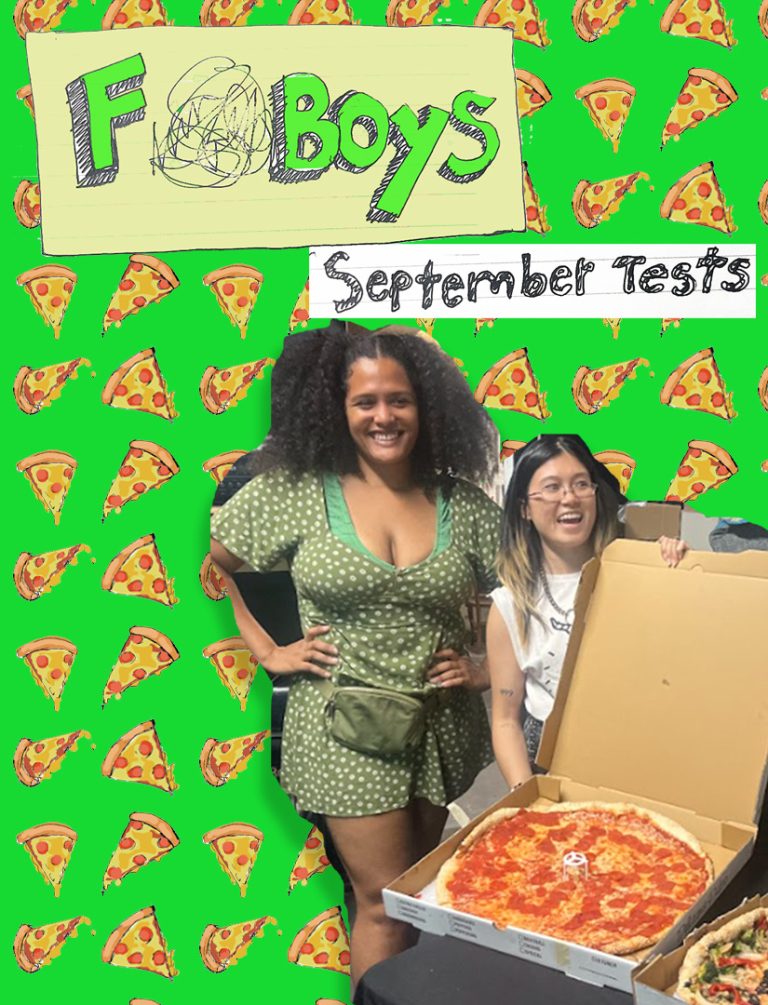
Intro:
This past September we started test screening our feature film “F@#$ boys” If you’ve been staying current with us, you must be here for the update.
During these test screenings, we hosted 45 guests at our small studio cinema in Brooklyn. We had pizza, snacks and good vibes. Attendance, like the movie, reflected diversely; a real grab bag of friends and community members. We were (I was) nervous; however, at each screening, those who attended gave us the reassurance that they were here for the process.
After taking a break to recoup energy and reflect on these first screening experiences, I’m ready to tell you how it all went.
How did people respond to the full movie screening? Overall, I’d say people responded positively.
Did they like it, were they offended? I didn’t hear about anyone being offended, some people thought the topics were more mature than expected.
Did people fall asleep? Yes, it wouldn’t be a proper screening without aunts and uncles falling asleep in the middle.
Was the whole thing full of confusion? There was some confusion, not the whole thing.
We now have a better understanding of what needs to be done.
Before I get into it, you might be thinking:
“Dilenia! Why don’t you just update us when the film is already at a film festival?”
“Why don’t you just submit the film to a film festival if you want people to see it?”
Or the biggest one,
“When can I see it? Is there a link (Youtube/Vimeo – Password is okay, you can trust me *not to share it…)
There are those that are eager for a function that is a real Premiere, though I want to continue to encourage you to join us in these more intimate movie-related events.
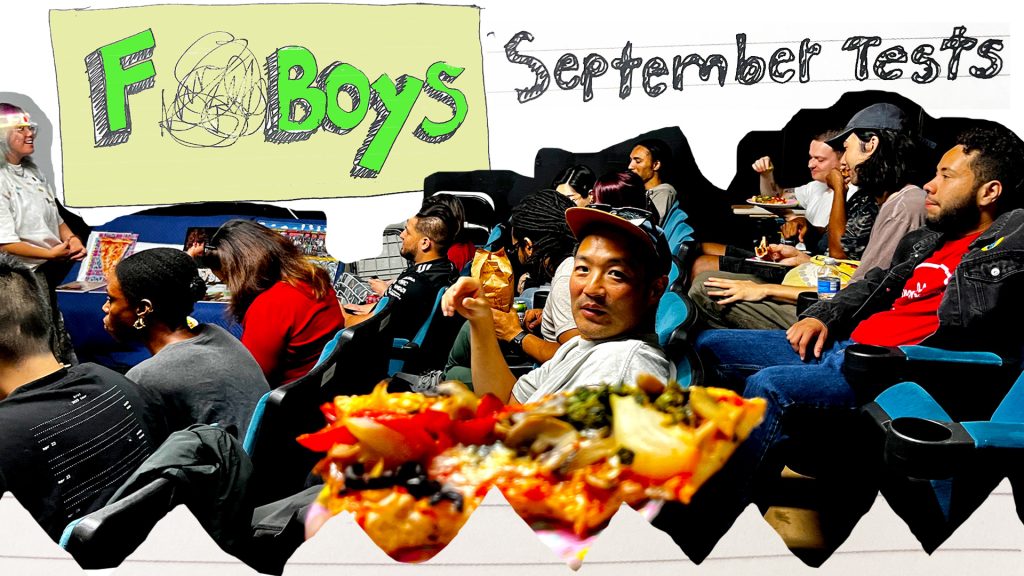
It’s important to me that we maintain and grow what’s at the core of this project. A production centered around making connections and being in community in the process of making media. We do this through conscious inclusivity and in-person activations. The in-person events are where we get to discuss and be collaborative in the production of this story and the discussion around it. Pair that with food, snacks and beverages and an open dialogue: That’s good vibes.
The start of this project was an in-person – everyone in the room audition. Why not self tapes D? Well, when I set out the plan for this production, I was considering the things that we miss out on when we make the production process highly exclusive, a selective experience – increasingly online. The audition process where actors read in isolation can be good (for the producers) but very limiting in an indie practice; the structure doesn’t lead to the flexibility that’s called for in an independent low budget project.
Now we are on a different phase of the project – beginning of the exhibition phase, it is important to us that we hold space for the community in it. To create as many opportunities for those involved in the film to interact with the people watching it, taking in their performance. This is where filmmaking becomes a powerful tool for community discussions.
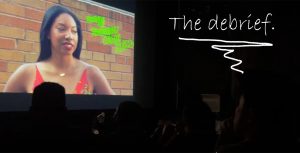
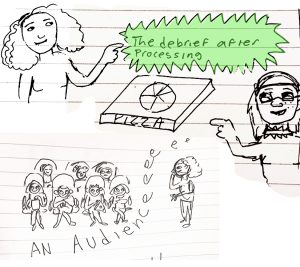
Aside:
A common goal of indie projects is to make a “sample project” of what can be done if we were fully funded by a more established (financially) studio. This is often the case for projects submitted to festivals, contests etc. To write proposals, curate pitch decks, so that some entity behind the screen can give you the funds to make this passion project happen. In other words — a common track for indie projects is to convince other film people (gatekeepers) that we can make a project worth funding. Early on, when submitting the F@#$ Boys shorts, scripts and deck, I figured that may not be the right path for the production of this story. This production was calling for it to be made more in-person, more hands-on.
The test screenings were not only calling for feedback on the project, but they were trial runs for how we facilitate the discussion on the topics that the film deals with. This is why we incorporate the audience during these test screenings in the credits of the film.
There’s an interesting sensation about testing a film. At work (in the production industry), it’s a little medical of an event. Audiences have to leave their phones outside. Their feedback and criticisms are recorded and (for big studios) they can cause productions to change the elements of the film that aren’t working. This is different for us, we don’t have the budget to go on and add scenes and cutting out parts would feel like a waste. I do consider it disrespectful to cut out people’s work entirely off a project. Understanding that there are hierarchies in this production, but that those hierarchies live within the creative network that we built while producing this show. Each scene costs individuals – time and energy. When a big budget film does testing, they seem to have more frivolous spending to re-do or re-shoot or scrap entire projects. F234 doesn’t have the liberty of frivolous and fickle investments. We test to prepare for the questions that come next.
Articulating that the film’s production can be an interactive process for as long as we need to keep it that way.
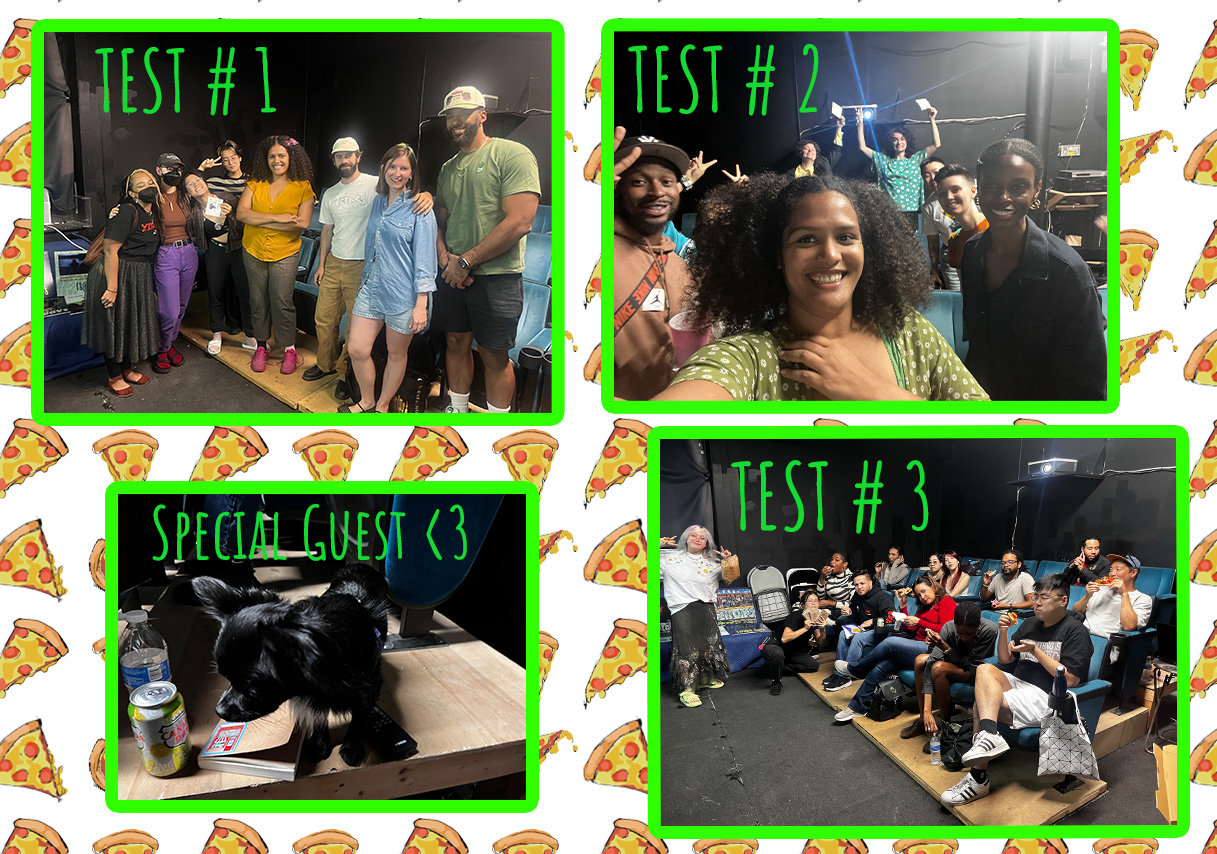
We welcomed the first audience to the studio theater on September 12th, 2025 — honestly, a tense week. We worked hard to put together the first full render of the film.
Editor’s Rant: After multiple export attempts, we were cutting it close. The screening started at 8PM and it was 6PM on September twelfth and the project was still rendering, for the third time that day. It was rendering at the speed of a snail rowing a boat on a stream of molasses. Whatever imagery that alludes to, for hours we watched as each frame rendered.
In the meantime, I made popcorn bags and prepped the food and snacks for the screening. I had to keep it to myself – not to let my anxiety know that we were running right on time. By 6:30 PM, Kara headed to the studio, not to keep any early-comers waiting. And the space needed vacuuming and prep for guests. It was a bit of a – we put it together how we can event. Someone had offered to help us with set-up, but dropped off at the last minute; however, someone else arrived early and helped us vacuum and set-up the snack. Big shout out to the homie HMA.
The project finally finished exporting at 7:20 PM, by then I had called a ride to the studio. Throughout these tests, the 25 minutes on the way to the studio, felt like they were happening in the liminal space before being born. What was I going to say to the people that came all this way to watch the first test? We hadn’t even had enough time to check if this file was – a good render.
If you dare judge our preparedness, both Kara and I had work that day and week, things were piling up. I got to the studio around 7:45 PM, scrambling to set-up the food and turn on the projector: The colors weren’t right. We rushed to tune the projector settings, but the first guests started arriving.
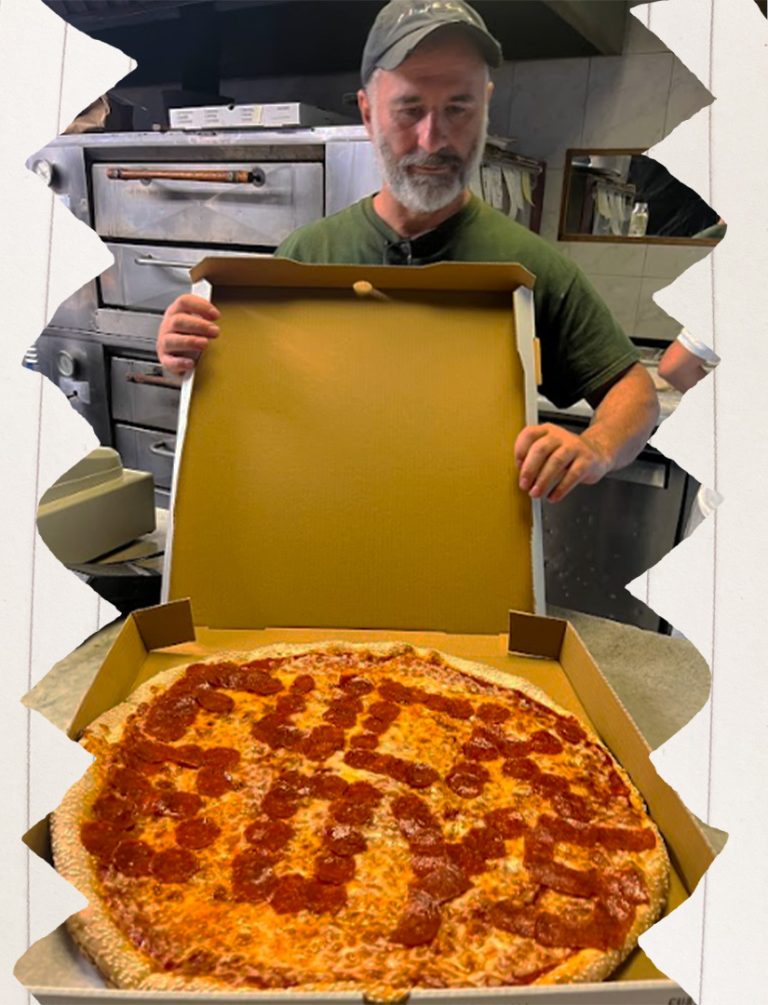
Welcome! Welcome! Grab some food, get a drink.
Have you met so and so?
These weren’t strangers, the people who showed up were colleagues, friends and community members. Some mysterious RSVP’s that we weren’t so closely acquainted with, but our first twenty person screening was booked out. Some guests were running late, so I decided to stall and practice my opening speech. How to greet friends? An audience to our first feature film screening? People’s parents were there, you can imagine the nerves of introducing the “F@#$ Boys” film.
Among our first guests, our leading star Elizabeth Baker and her parents who came all the way from Philly. Benny, a mentor, friend and colleague in the “guerilla” (or gorilla) style indie filmmaking world. Annie, our stylist and collaborator in the film. Studio mates and their partners. We welcomed new faces, Laura, Nathan and friends; who drove from New Jersey to watch this first screening. We also had friends who showed up from along the way, people we met in passing who took interest. Overall, a true test audience.
At this time the technicalities of the screening event were my biggest concern. However, I must admit that I felt sad, there were people I was expecting to attend that didn’t show. I was feeling the disappointment of their absence in real time: Combined with the nerves of this first test.
We had to start playing the movie!
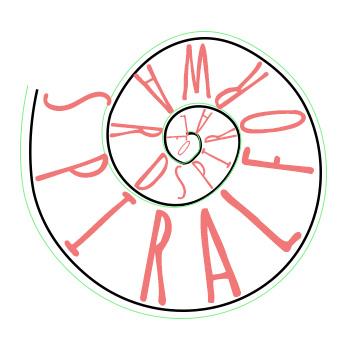
This first test was tricky because the projector colors and sound system weren’t tuned up right. Also, we missed a whole five minute section of the film (of course only I could tell). Oh! The embarrassment, that the first go at it wasn’t perfect: it took over me at the end of the night.
I looked around the room during the screening and listened to the sounds from the attentive audience. Happy that the humor in the first ten minutes was well received. A successful audience connection to the primary elements of the film. When I was writing the F@#$ Boys script, I tried to imagine how these first moments of the movie depict the humorous and awkward moments of the teen years. Having the audience’s laugh reaction to those moments, marks a check for the hook (that I intentionally placed in that part of the script).
Montay Savoy’s performance as Carlos welcomes the audience into the world of the F@#$ Boys. What does a seventeen year old boy do when they find that they’re home alone? What does he think he can get away with? With internet access to some of the most crude — content, that people have ever had access to.
The film continues onto its first shift in the tone, where it loses its innocence and gets into the substance. The sound was low, but on the screen colors turned to red and one could feel it shifting the tone in the room as people watched it.
The screening goes on with some minor hiccups here and there, and finally the credits: Which had hand drawn animations for each of the people involved in the making of the film. Going into the sunset to the tune of Jaxx Michelle’s “Trust in Me”, and people clapped.
The lights came on and people remained seated. I guess my fear was that people were going to hate it so much that they would walk out mid screening offended– did not come true.
Kara handed out note cards and facilitated a moment for people to write down their thoughts and feelings about the film. One first question broke the silence: “What were your references?” I was prepared, but was better able to articulate it the second time around.
Some scenes draw on classic film references. One in particular is the tone shifting scene I described earlier, that takes place in the first twenty minutes of the film, the TBD sequence (you’ll know when you watch the movie). This moment was a criticism of Antonioni’s “Red Dessert” an Italian film, I learned about in a European Film history class: It depicted an assault on a woman by a man, and the room turned pink to imply that the assault “fixed” the issues that the couple had in their relationship. In my perspective, it’s a film that romanticizes the abuse of women by their male partners. So in F@#$ Boys, this is a bright contrasting red, and very apparent that we aren’t making this easy relief from conflict but rather a traumatic point for the main character.
Another aspect of the film references classical literature and some films that draw on that. The Odyssey informs part of the structure of the film, it’s an epic journey for a teenage girl going into adulthood.
Highlighting a moment in the discussion: Where a woman directed her question to the men in the room – “How do you feel when you see this pain that men can cause to women? Have any of you experienced or have been involved in something like this?” The question went partly unanswered on the first screening, but on the second test (September 19th), we had a brave young man give an honest response. He said that —

As a young man, a handsome, sports player, I never had issues finding girlfriends early on in life. At the time, I would treat girls with that sort of disrespect, I’d go on from one to the other without concern for the suffering that it caused them. I never considered the lasting damage that the f*ckboy behavior entails.
It was shocking to hear this level of accountability being brought out on the second test screening. He said that the film helped him to see the pain through the character that is caused to young women (girls) as they enter adulthood.
The discussions during the tests brought out every element in the story. A few indie film people said that they really liked the character development in the story. We saw similar dynamic responses throughout the screenings, some things stood out to me. One of our black audience members wrote in their note cards “I feel my story reflected in Ella’s character”. That has been a constant through the screenings, that the people of color — friends, colleagues, community members, they made sure to let me know that they felt connected to the characters and her story. I’ve received many kind and optimistic messages from the people of color who attended the film saying “I like it, this is important to talk about”.
Our last screening, on September 26th, drew in our largest audience, all the homies pulled up for our last test screening. On this last test we were better prepared with the sound in the room, snacks and drinks were figured out. A “F*ck Boys” pizza thanks to Joeys Pizza in Queens: To go with the pizza themes in the film. It was brought up in one of the tests: Pizza is a character in the film too. Pizza is the quintessential meal of the coming-of-age young adult phase, that quickly drags when one is not eating any food with nutrients.

During our last discussion we were able to highlight the music composer, our music Director Laura Fan. There are moments in the original score brought up in the discussion that were received in the meaning that our composer intended. Leading us to discuss some of the more niche references in the film’s music composition and expand on the various meanings and interpretations of the project.
Observable: The feedback we received that the film can feel long for some people — it is a two hour runtime, fifteen minutes longer than the script. Another critique was about the confusion during the more disjointed time sequences. Not to spoil any parts, but there’s a jump forward to the flashback bit, which takes people a little bit to catch up. I like to defend this comment (which I got in the writing as well) – as a piecing together of childhood memories. As the structure of the film weaves in and out of memories and experiences the audience gets the set-up for the main storyline between Ella and Elliott. I think the confusion critique about the beginning of the film, allows the audience to think better about the circumstances the character finds herself in at the end of the play. In this sense, the points of confusion are part of the achievements of this film.
I did peep the mistakes we made during the production process, but as it goes, the mistakes I noticed – having watched it for the millionth time, weren’t as apparent to a new audience.
The film knows itself. What do movies do that help us integrate in society? They evoke conversation about the topics that they deal with. This year I’ve seen a select number of shows that have captivated me. The writing leads me to thoughts and opinions that I can share with and discuss with the people I talk to in my daily life. Everyone can discuss a movie or show, not just the cinefiles. I noticed that in the “Streaming age” we overlook this aspect of movie consumption: That they provide an avenue to discuss important issues that can be hidden when speaking in personal and relational dynamics. But the F@#$ Boys movie project asks for us (the makers and the audience) to slow down this discussion and create something more than a quickly fading viral moment. To dissect and build on the discussion — What is a F*ckboy? What is this movie talking about and why does it matter?
These test screenings were successful because they reinforced the intentions behind the project. We’re still working on fine tuning and polishing the final movie file. However, we can observe, even in these small tests, that the film’s discussion runs deep. That Fuck boys is talking about something that we are feeling and seeing in the romantic relationships in our lives, that gets continuously buried under the unseriousness, but that continues to affect the lives of women and men — and highlights, why the conversation about women’s rights needs to be carefully considered and informed.
Stay tuned for the next round of screenings, The previews.
